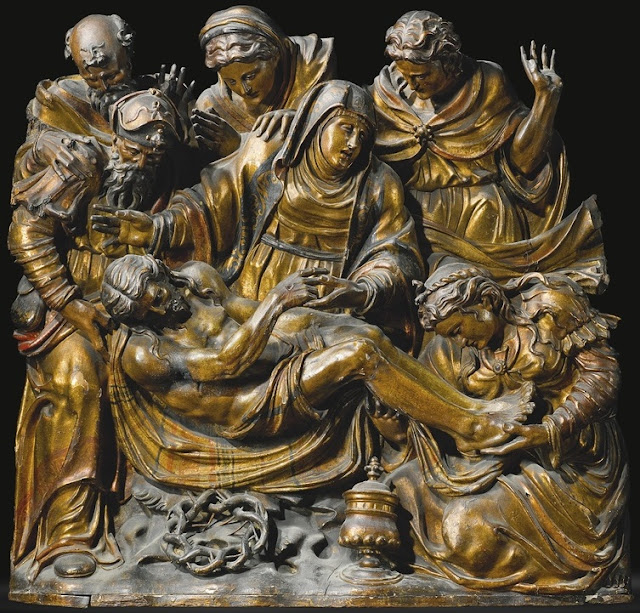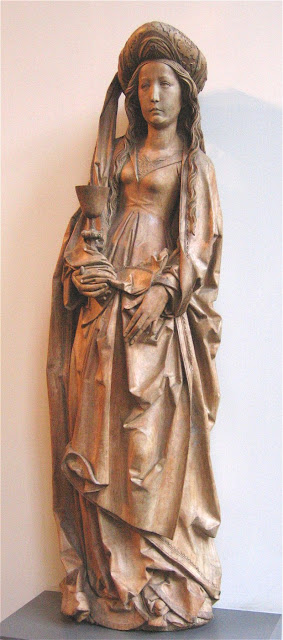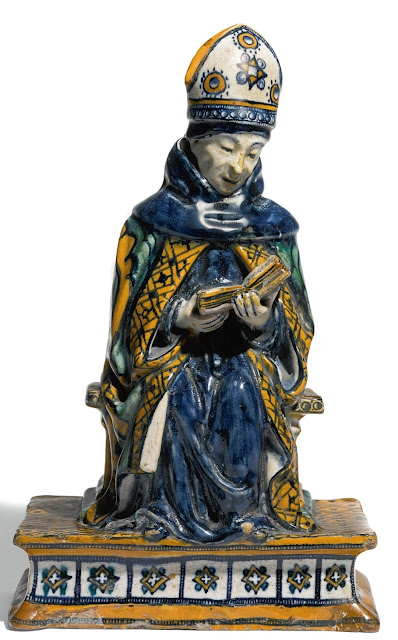Circle of Hans Multscher (circa 1400-1467), German, Ulm, circa 1430-1440
SAINT CATHERINE
gilt and polychromed wood
93cm., 36 5/8 in.
The rich drapery and contrapposto stance are seen in Multscher's female figures from the second quarter of the fifteenth century. Although the present figure's slender forms are not typical of female figures by the sculptor, they find a comparison in the fragmented Angels surrounding 'Karg-Nische' at Ulm Minster of 1433, which are also characterised by their animated drapery. It is likely that the St Catherine was executed by a sculptor from Multscher's close circle, if not his own workshop. More
Hans Multscher (ca. 1400–1467) was a German sculptor and painter. He made himself with new artistic styles from northern France and the Netherlands, and became a free citizen of the city of Ulm in 1427. There, he married Adelheid Kitzin the same year. He ran his own business as a painter and sculptor, together with his brother Heinrich Multscher. More
Hans Multscher (1400–1467
Female Saint.
Date mid 15th century
Polychromy on wood
128.4 × 48 × 33.2 cm (50.6 × 18.9 × 13.1 in)
]National Museum in Warsaw
Atelier of Hans Multscher
Madonna and Child, c. 1450
Main-Franconian Museum, Fortress of Marienberg, Würzburg, Germany
English, Nottingham, first half 15th century
RELIEF WITH CHRIST WASHING THE FEET OF THE APOSTLES
Alabaster, with traces of gilding and polychromy, on a wood mount
Alabaster: 52cm., 20 1/2 in.
56 by 28.5cm., 22 by 11 1/4 in. overall
Swiss or Austrian, early 16th century
SAINT CLEMENT
polychromed pine
88cm., 34 5/8 in.
Pope Clement I (died 99), also known as Saint Clement of Rome, is listed as Bishop of Rome, holding office from 88 to his death in 99. He is considered to be the first Apostolic Father of the Church.
Few details are known about Clement's life. Clement was consecrated by Saint Peter, and he is known to have been a leading member of the church in Rome in the late 1st century. Early church lists place him as the second or third bishop of Rome after Saint Peter. It was Clement that Peter entrusted the Church as a whole, appointing him as his successor. Tertullian considered Clement to be the immediate successor of Peter.
Many legends surround Saint Clement, some suggest he was the first man to refine iron from ore, and to shoe a horse. Clementine customs may be survivals of earlier pagan rituals, a confusion of Saint Clement with the early Saxon Wayland, or Wayland the smith, a mythical metalworker. He shares this feast day, which marks the beginning of winter, with the saint.
Clement was banished from Rome to the Chersonesus during the reign of the Emperor Trajan and was set to work in a stone quarry. Finding on his arrival that the prisoners were suffering from lack of water, he knelt down in prayer. Looking up, he saw a lamb on a hill, went to where the lamb had stood and struck the ground with his pickaxe, releasing a gushing stream of clear water. This miracle resulted in the conversion of large numbers of the local pagans and his fellow prisoners to Christianity. As punishment, Saint Clement was martyred by being tied to an anchor and thrown from a boat into the Black Sea. More
A so-called 'Poupée de Malines'
polychrome and gilt decorated walnut
Low Countries - Malines
16thC, H 34,5 cm
Circle of Guyot de Beaugrant (circa 1500-1549), Spanish, mid 16th century
THE LAMENTATION
gilt and polychromed wood, with a later pine base
group: 80 by 79cm., 31 1/2 by 31 1/8 in
The Lamentation of Christ is a very common subject in Christian art from the High Middle Ages to the Baroque. After Jesus was crucified, his body was removed from the cross and his friends mourned over his body. This event has been depicted by many different artists.
Lamentation works are very often included in cycles of the Life of Christ, and also form the subject of many individual works. More
Circle of Hans Klocker (active 1478-1500), South Tyrolean, circa 1490-1500
VIRGIN AND CHILD
gilt and polychromed wood
130cm., 51 1/4 in.
Hans Klocker (before 1474-after 1500) was a late Gothic sculptor, active in South Tyrol; at the court of the bishop of Brixen since 1477, although he is mentioned for the first time in this context in 1482. He is known to have created an altarpiece for the church in St. Leonhard in Passeier in 1486-90 and 1498 he was working on another for the church in Kaltern an der Weinstraße. The last time his name is mentioned is in 1500, when he made an altarpiece for the Franciscans in Brixen. Altarpieces by his hand are also known from Tramin an der Weinstraße (now in the Bavarian National Museum, Munich), Montan (now in Bolzano City Museum) and South Tyrol. More
German, Lower Bavaria, circa 1510
RELIEF WITH ANNA SELBDRITT
Representation of St. Anne with her daughter Maria and the baby Jesus
polychromed limewood
73 by 58cm., 28¾ by 22 7/8 in.
Southern German, circa 1510-1520
ANNA SELBDRITT
Representation of St. Anne with her daughter Maria and the baby Jesus
gilt and polychromed limewood
60.5cm., 23¾in.
Southern Netherlandish, Brabant, early 16th century
GROUP WITH THE DEPOSITION OF CHRIST
The Entombment of Christ
partially polychromed and gilt wood
34 by 45cm., 13 3/8 by 17¾in.
Circle of Tilman Riemenschneider (c. 1460-1531)
German, Franconia, circa 1510
SAINT SEBASTIAN
limewood, on a modern wood stand
figure: 96cm., 37¾in.
stand: 2.5cm., 1in
Saint Sebastian (died c. 288) was an early Christian saint and martyr. According to Christian belief, he was killed during the Roman emperor Diocletian's persecution of Christians. He is commonly depicted in art and literature tied to a post or tree and shot with arrows. Despite this being the most common artistic depiction of Sebastian, he was, according to legend, rescued and healed by Irene of Rome. Shortly afterwards he went to Diocletian to warn him about his sins, and as a result was clubbed to death. He is venerated in the Catholic and Orthodox Churches. More
Tilman Riemenschneider (c. 1460 – 7 July 1531) was a German sculptor and woodcarver active in Würzburg from 1483. He was one of the most prolific and versatile sculptors of the transition period between late Gothic and Renaissance, a master in stone and limewood. More
Circle of Tilman Riemenschneider (c. 1460-1531)
German, Franconia, circa 1510-1530
SAINT BARBARA
with a label to the reverse with a faint inscription in ink: ... Bapa ...
gilt and polychromed limewood
112.5cm., 44 1/4 in.
Saint Barbara, known in the Eastern Orthodox Church as the Great Martyr Barbara, was an early Christian saint and martyr. Accounts place her in the 3rd century in Nicomedia, present-day Turkey or in Heliopolis of Phoenicia, present-day Baalbek, Lebanon. Her name can be traced to the 7th century, and veneration of her was common, especially in the East, from the 9th century.
Barbara, the daughter of a rich pagan who carefully guarded and kept her locked up in a tower in order to preserve her from the outside world. Having secretly become a Christian, she rejected an offer of marriage that she received through him.
Before going on a journey, he commanded that a private bath-house be erected for her use near her dwelling. When her father returned, she acknowledged herself to be a Christian; upon this he drew his sword to kill her, but her prayers created an opening in the tower wall and she was miraculously transported to a mountain gorge, where two shepherds watched their flocks. Dioscorus, in pursuit of his daughter, was rebuffed by the first shepherd, but the second betrayed her and was turned to stone and his flock changed to locusts.
Tilman Riemenschneider
Saint Barbara, c. 1510
Bayerisches Nationalmuseum
Dragged before the prefect of the province, Martinianus, who had her cruelly tortured, Barbara held true to her faith. During the night, the dark prison was bathed in light and new miracles occurred. Every morning her wounds were healed. Torches that were to be used to burn her went out as soon as they came near her. Finally she was condemned to death by beheading. Her father himself carried out the death-sentence. However, as punishment for this, he was struck by lightning on the way home and his body was consumed by flame. Barbara was buried by a Christian, Valentinus, and her tomb became the site of miracles. More
Southern German, Bavaria, circa 1520
FEMALE SAINT
gilt and polychromed limewood
68cm., 26 3/4 in
Italian, Faenza, circa 1500
SEATED BISHOP
glazed earthenware
31cm., 12¼in.
Northern Italian, 16th century
PAIR OF KNEELING ANGELS
polychromed and gilt wood
46cm., 18 1/8 in. and 46.5cm., 18¼in.
Polychrome and gilt decorated wooden Holy Virgin and Child,
Low Countries, late 17thC, H 71 cm
A polychrome and gilt decorated oak
Female Saint
late 17thC, H 60,5 cm
A polychrome and gilt decorated wooden Saint with baby Jesus
17thC, H 64,5 cm
A polychrome decorated limewood Saint,
Early 18thC, H 44,5cm
A polychrome decorated limewood Saint
17thC
H 84,5cm
A limewood female Saint,
17thC,
H 66,5 cm
A polychrome and gilt decorated wooden Saint Roch
probably French,
Late 17thC
H 84,5cm
Saint Roch or Rocco , c. 1348 – 15/16 August 1376/79, was a Catholic saint, and a confessor. He is specially invoked against the plague. He is a patron saint of dogs and falsely accused people, among other things.
He was born at Montpellier, at that time "upon the border of France", the son of the noble governor of that city. Even his birth was accounted a miracle, for his noble mother had been barren until she prayed to the Virgin Mary. Miraculously marked from birth with a red cross on his breast that grew as he did, he early began to manifest strict asceticism and great devoutnes.
On the death of his parents in his twentieth year he distributed all his worldly goods among the poor like Francis of Assisi—though his father on his deathbed had ordained him governor of Montpellier—and set out as a mendicant pilgrim for Rome. Coming into Italy during an epidemic of plague, he was very diligent in tending the sick in the public hospitals at Acquapendente, Cesena, Rimini, Novara and Rome, and is said to have effected many miraculous cures by prayer and the sign of the cross and the touch of his hand. At Rome he preserved the "cardinal of Angleria in Lombardy" by making the mark of the cross on his forehead, which miraculously remained. Ministering at Piacenza he himself finally fell ill. He was expelled from the town; and withdrew into the forest, where he made himself a hut of boughs and leaves, which was miraculously supplied with water by a spring that arose in the place; he would have perished had not a dog belonging to a nobleman named Gothard Palastrelli supplied him with bread and licked his wounds, healing them. Count Gothard, following his hunting dog that carried the bread, discovered Saint Roch and became his acolyte.
On his return incognito to Montpellier he was arrested as a spy (by orders of his own uncle) and thrown into prison, where he languished five years and died on 16 August 1327, without revealing his name, to avoid worldly glory. More
A polychrome decorated wooden female Saint
17thC
H 102 cm
A polychrome decorated limewood Holy Virgin and Child,
17thC
H 91 cm
Acknowledgement: Carlo Bonte, Sotheby's,


























No comments:
Post a Comment